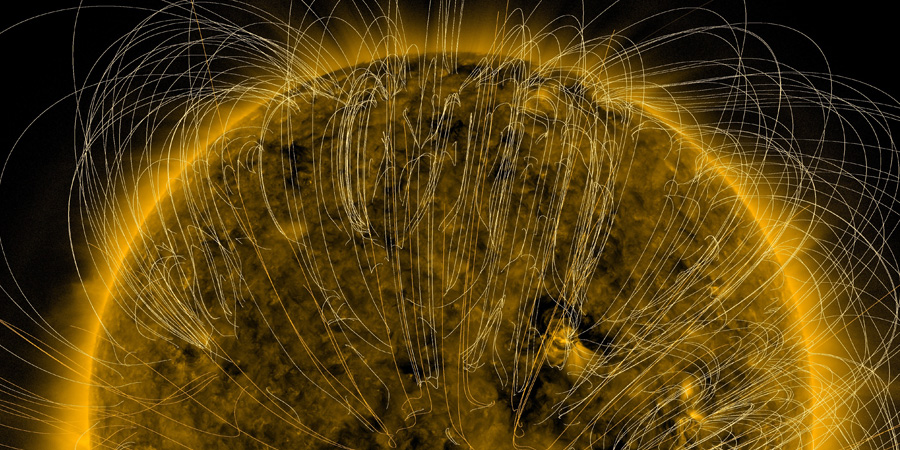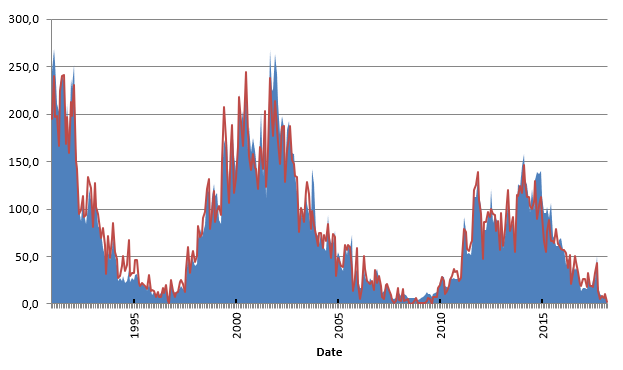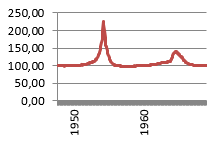Solar Cycle 25 and the 10.7 cm radio solar flux
Wednesday, 2 January 2019 18:57 UTC

Following our previous guest post regarding the upcoming Solar Cycle 25 we have yet another guest post. This time from Patrick Geryl. Patrick does research in astrophysics, especially everything related to the Sun. He has currently published 3 articles on Researchgate. At this moment he is working with Jan Alvestad from Solen on an article: “High Resolution Sunspot Calculations.” He hopes to makes his breakthrough with his prediction about the start of Solar Cycle 25. Patrick claims that Solar Cycle 25 started in November 2018. How did he came to this conclusion? Keep reading to find that out.
Our Sun has an 11 year cycle. The last cycle started in December 2008. Therefore many astronomers think cycle 25 will start late 2019. Some even think 2020 or as late as 2021. We found it already started in November 2018. How did we come to this conclusion?
The 10.7 cm solar radio flux, which originates high in the chromosphere of the Sun and low in the corona of the solar atmosphere, is an excellent indicator of solar activity. The F10.7 radio emissions measurements are completely objective, because they can be made in all types of weather. It is one of the longest running records, provides solar activity over six solar cycles, and has proven very valuable in forecasting space weather.
There exists a relationship between the solar 10.7 cm radio flux (F 10.7 index) and sunspots. We found a new formula (there is currently none), to calculate the sunspot number from the radio flux. It looks like this:
Fitted sunspot number (blue) vs monthly mean sunspot number (red)
Figure 1. January 1991 – March 2018. The blue values were calculated from the 10.7 cm radio flux and fit relatively well with the observed sunspot number (red) Source: S.I.D.C. Brussels International Sunspot Number. 10.7cm radio flux values (sfu): Penticton, B.C., Canada.
Strangely enough there is huge differences at the low of the cycles. For instance, we calculate a sunspot number from 1 while it is 3, a 300 percent difference. Why was this the case?
Our research delivered a surprising relationship, at the low of the cycles, between the fitted adjusted flux divided by the fitted sunspot number. This gave us a nearly 100 % correlation with the start of a new sunspot cycle:
Figure 2. September 1947 – January 1969. The peaks are exactly at the start of a new cycle. Source: S.I.D.C. Brussels International Sunspot Number. 10.7cm radio flux values (sfu): Penticton, B.C., Canada.
Normally you have to wait at least 6 months before we know when a new sunspot cycle has started. However, we found more relationships to find the start of a new cycle. For instance the month with the lowest flux value can give as a clue, because it is close to the start of a new cycle. November 2018 had the lowest flux value till now, and therefore the new cycle can start in a time frame from October 2018 till February 2019.
More specific clues point to November 2018 as the start of solar cycle 25.
More details can be found in this paper which is available at Researchgate.
Thank you for reading this article! Did you have any trouble with the technical terms used in this article? Our help section is the place to be where you can find in-depth articles, a FAQ and a list with common abbreviations. Still puzzled? Just post on our forum where we will help you the best we can!
Latest news
Latest forum messages
Support SpaceWeatherLive.com!
A lot of people come to SpaceWeatherLive to follow the Sun's activity or if there is aurora to be seen, but with more traffic comes higher server costs. Consider a donation if you enjoy SpaceWeatherLive so we can keep the website online!

Space weather facts
| Last X-flare | 2024/05/03 | X1.6 |
| Last M-flare | 2024/05/03 | M2.7 |
| Last geomagnetic storm | 2024/05/02 | Kp7- (G3) |
| Spotless days | |
|---|---|
| Last spotless day | 2022/06/08 |
| Monthly mean Sunspot Number | |
|---|---|
| April 2024 | 136.5 +31.6 |
| Last 30 days | 149.4 +51.8 |




